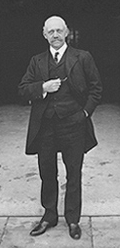Spring forward, fall back
 It’s that time of year when we gain an extra hour here in the UK. On Sunday 27th October 2013, British Summer Time (BST) ends and Coordinated Universal Time (UTC) – perhaps more commonly known in this country as Greenwich Mean Time (GMT) begins.
It’s that time of year when we gain an extra hour here in the UK. On Sunday 27th October 2013, British Summer Time (BST) ends and Coordinated Universal Time (UTC) – perhaps more commonly known in this country as Greenwich Mean Time (GMT) begins.
But why do we change the clocks forward and back each year? Today we’ll take a trip through time and look at the history of daylight savings.
A brief history of (daylight saving) time
 In 1907, William Willett, a builder by trade had become frustrated that potentially productive daylight hours were being lost whilst the country slept. Willett campaigned vigourously and pushed the government to adopt his proposal of advancing the clocks by 80 minutes (in four 20 minute steps) in the spring and then return them to GMT in the autumn.
In 1907, William Willett, a builder by trade had become frustrated that potentially productive daylight hours were being lost whilst the country slept. Willett campaigned vigourously and pushed the government to adopt his proposal of advancing the clocks by 80 minutes (in four 20 minute steps) in the spring and then return them to GMT in the autumn.
Willett gained the support of a member of parliament, but the proposed Bill was rejected by the House of Commons in 1908. In 1915, William Willett died having never seen his vision come to fruition.
Just over a year later and in the midst of war, Germany adopted daylight savings and Britain soon followed suit. It was 1916 that saw the first time changes from GMT to BST and so clocks were put in advance of GMT by one hour from the spring to the autumn up until the Second World War.
In 1940, double summer time (2 hours ahead of GMT) was introduced to increase daylight hours for wartime production. Clocks in Britain weren’t put back by an hour at the end of the summer in 1940 but were put forward by one hour in spring 1941 – making the winter time one hour ahead of GMT. In subsequent years, clocks were put forward by one hour each spring and back again in autumn until the end of the war in 1945.
The Summer Time Act was outlined in 1972 and stated that British Summer Time would begin at 02.00 GMT on the morning of the day after the third Saturday in March and was to end at 02.00 GMT on the day after the fourth Saturday in October. However, in 1998 the end of BST was changed. Summer (or daylight saving) time was now clarified as between the last Sunday in March to the last Sunday in October and clock changes would all be made at 01.00 GMT.
Did you know?
It was Benjamin Franklin who first advocated the idea of “summer time” or “daylight saving time” back in 1784 – by suggesting everyone get up earlier during the summer months!

What if we stayed with British Summer Time all year?
Some people have campaigned for keeping our clocks set to BST throughout the year to save on power costs and increase daylight hours for those who work. This is opposed by others as it would mean that the sun wouldn’t rise in places such as the north-west of Scotland until 10am! Of course, the UK isn’t the only place that adopts daylight saving time; it also occurs in the USA, Russia, most of Europe and the Commonwealth.
So, what will you do with your extra hour..?
